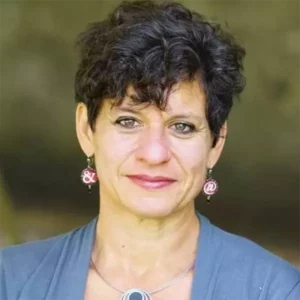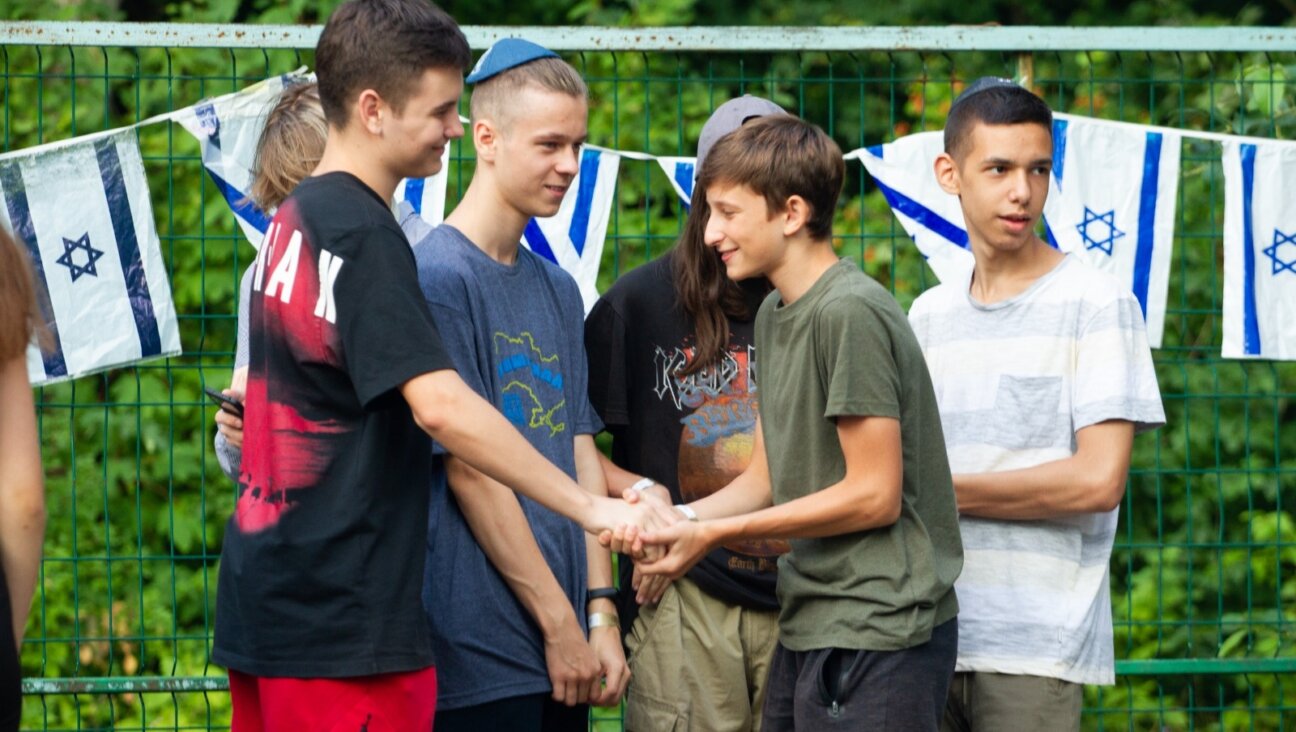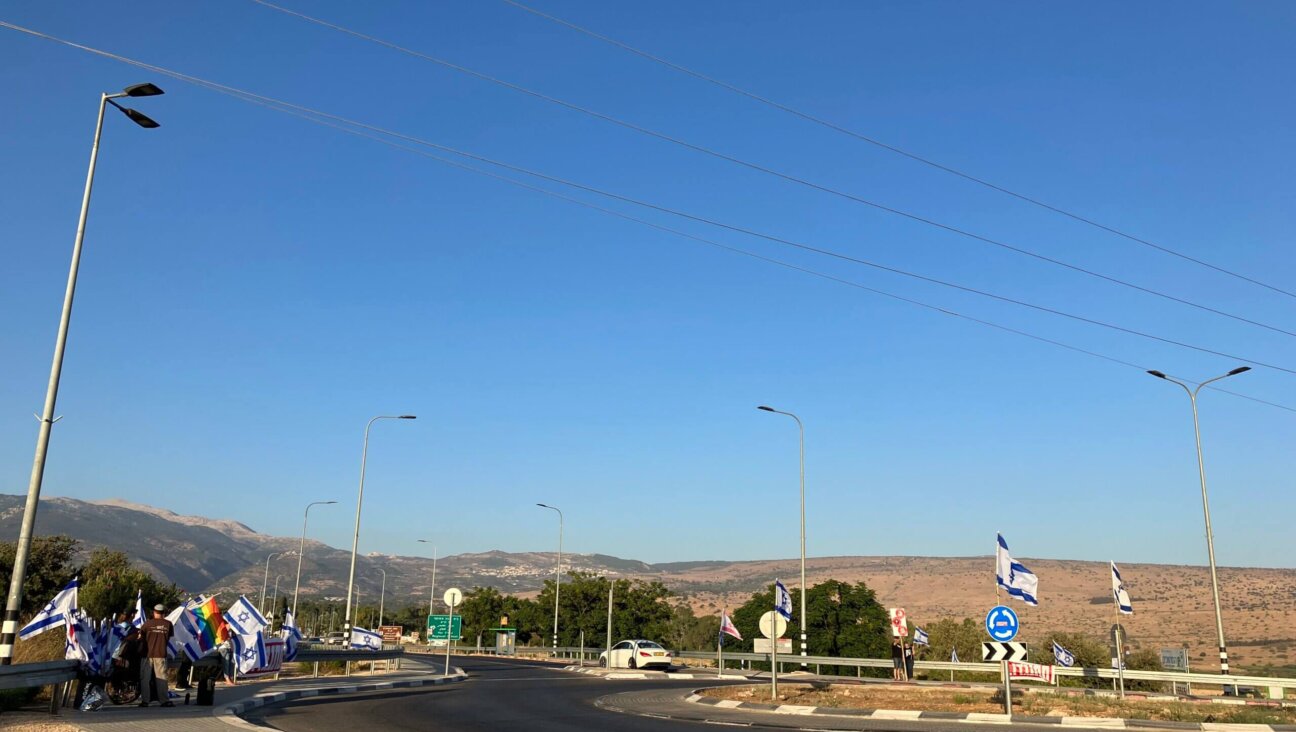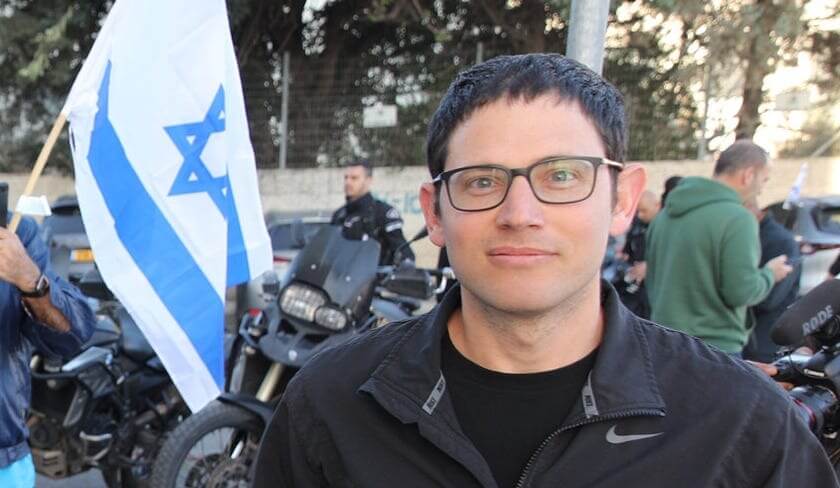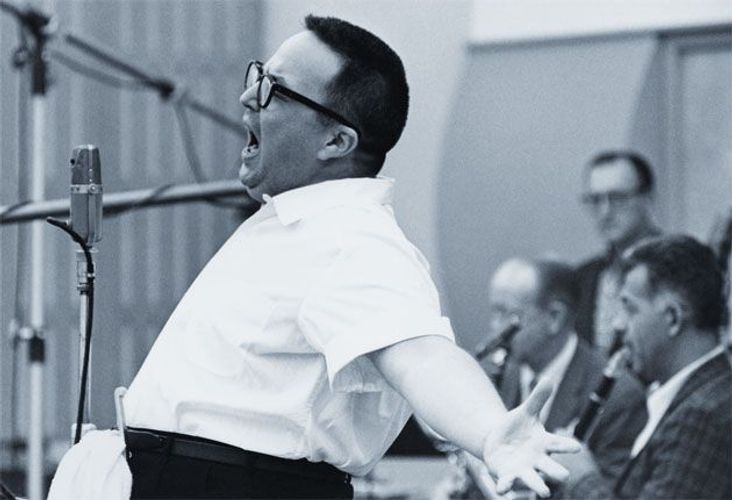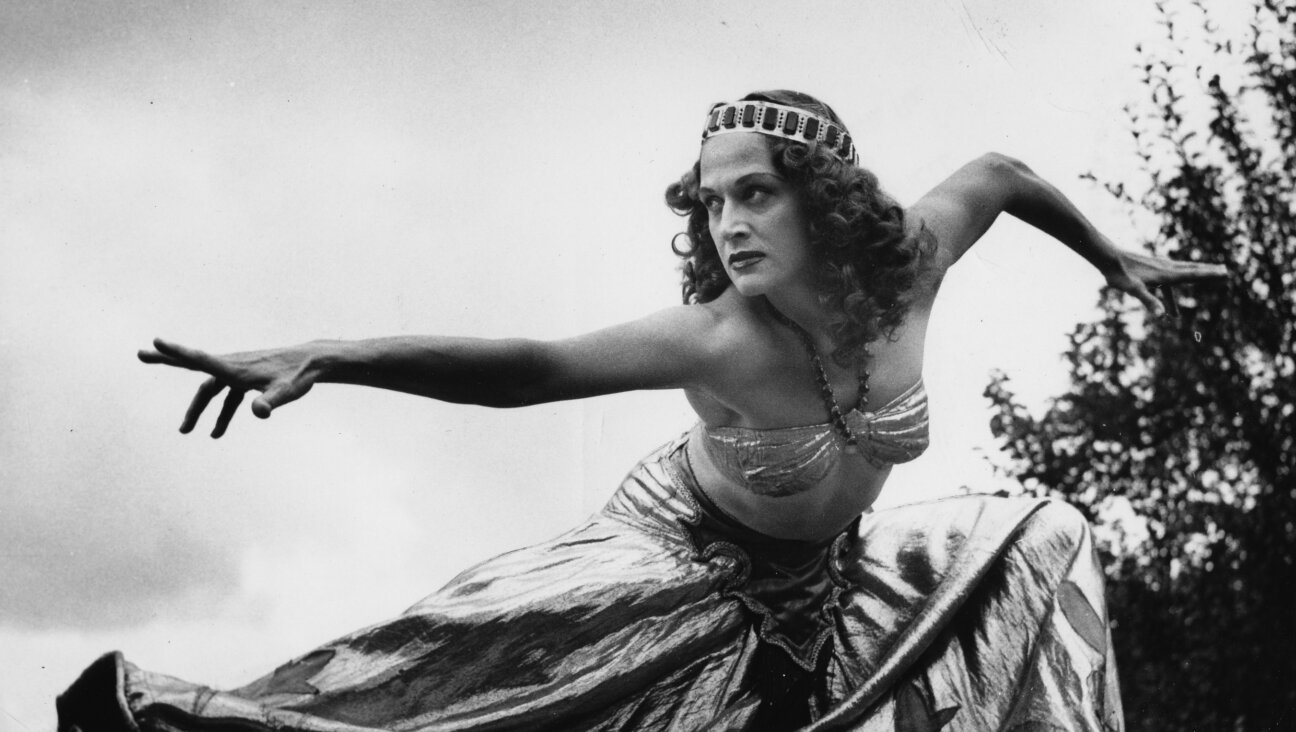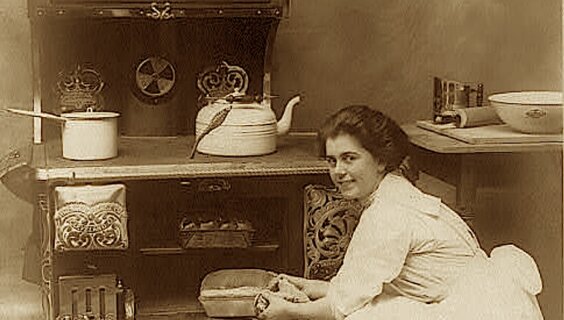‘Make for me a sanctuary’: Amid Orthodox ire, Tbilisi women read Torah for the first time
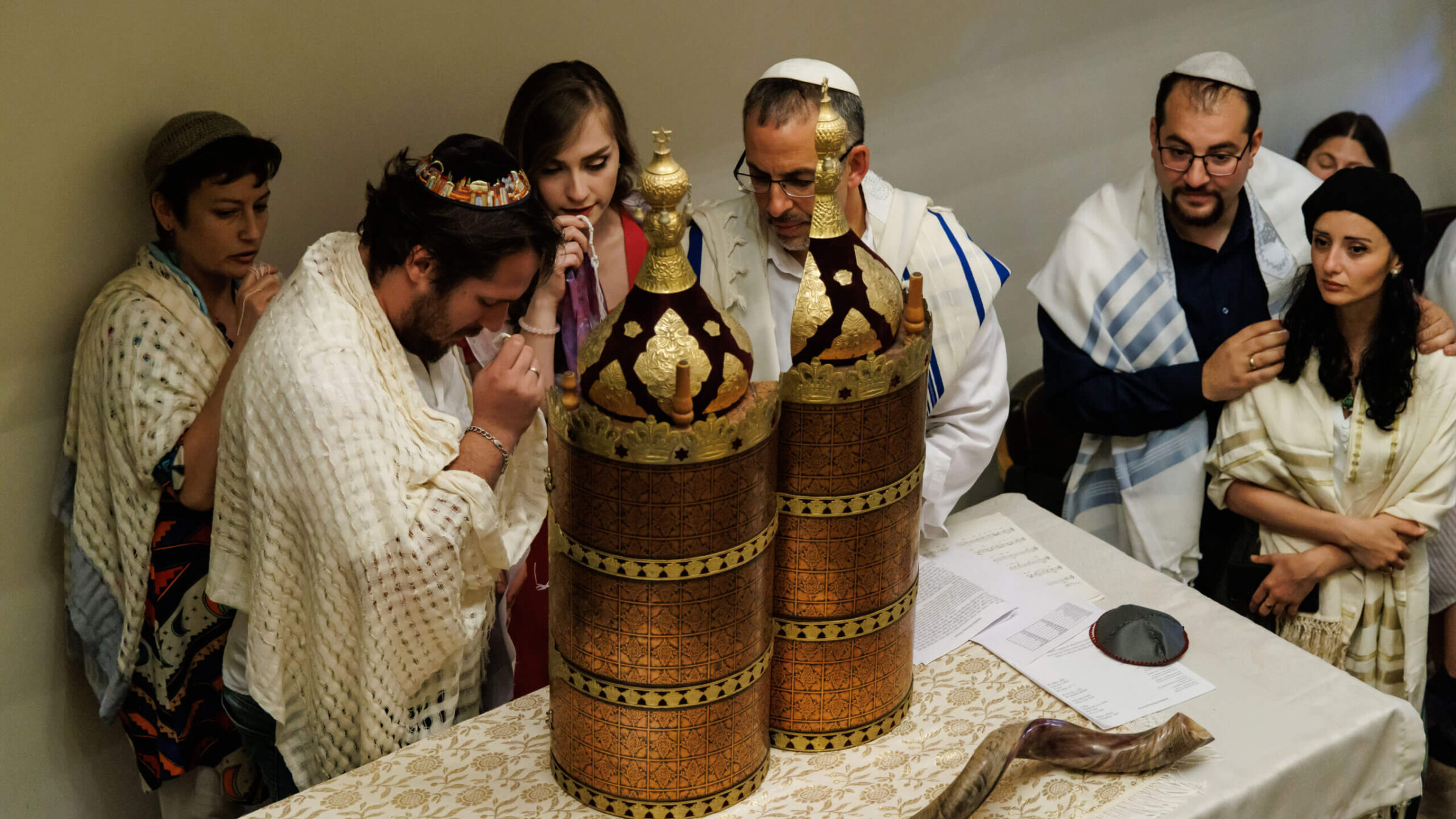
During the first b’nai mitzvah at Tbilisi’s Peace Synagogue, Nina Mgeladze, center, was one of the first women to read Torah in Georgia’s 2,600 years of Jewish history. Rabbi Golan Ben-Chorin of Haifa, to her left, ls the nascent congregation’s spiritual leader. At right are Misha Grishashvili, the synagogue’s founding president, and his wife, Keti Chikviladze, director of Georgia’s Hillel, both of whom also became b’nai mitzvah. Photo by Eli Deush Krogmann
TBILISI, Georgia – The first few shofar blasts Ilona Levinets blew were sputtering and shaky. It was an apt metaphor for her Jewish heritage, and that of the other young adults becoming belated b’nai mitzvah here in a startup synagogue made of ancient stones.
Their Jewish story is one of muddled and buried identity, of spiritual seeking often shunned in a post-Soviet republic still caught between Russia and the West.
Until now. Rabbi Golan Ben-Chorin, a visitor from Haifa, gave Levinets’ shoulder a squeeze, and she lifted the ram’s horn back to her lips. Her eyes widened as she sounded three strong, steady blasts.
There have been Jews in the republic of Georgia for some 2,600 years. But on this morning, Levinets, 34, and five others became the first women to ever read Torah in the country.
“It’s like a dream for me — out of nowhere, to be honest,” she said.
I traveled to Tbilisi with a group from my New Jersey synagogue to witness and support these women and the groundbreaking events they were part of on the last weekend in May. We were there to consecrate the first liberal, egalitarian Jewish prayer space in this conservative and Orthodox country — and, with it, the first complex containing a church, synagogue and mosque under the same roof in the entire world.
Georgia was once home to 100,000 Jews. As in neighboring countries, many converted or suppressed their Judaism during the Soviet era, and afterward, most moved to Israel. But while liberal Jewish communities have sprouted in Ukraine, Russia and Belarus, Georgia’s surviving synagogues are strictly Orthodox — and particularly old-fashioned.
Georgian rabbis here and in Israel denounced the emerging congregation, called the Peace Synagogue, as sinful both because of women’s participation and because of its connection to a church, the Peace Cathedral. They threatened the jobs of both the local Hillel director — one of the women who read Torah — and Israel’s ambassador, who attended the historic ceremony.
In a conspiratorial and hate-filled Facebook post, the rabbis promised a “severe and brutal response” to the progressive Jewish pioneers and their project.
The backlash was offensive. But I was also dismayed to discover that the rabbi and his recruits had made no outreach efforts to Tbilisi’s established Jewish leaders, however closed minded. I worried that their immersive approach to interfaith work would complicate their quest for a liberal Jewish home — I knew, for example, that even many pluralists would be shocked to see my synagogue’s cantor prostrate herself during a Muslim prayer service as an imam chanted “Allahu akbar,” because I was. And I thought the fact that one of the b’nai mitzvah was a Christian with no plans to convert threatened to undermine the milestone event.
When I asked Ben-Chorin if all this did not amount to giving his enemies ammunition, he shrugged me off. “Once you work from a perspective of what ammunition,” he said, “you’ve sort of lost the battle.”
It was a lot to absorb and process. But the b’nai mitzvah itself was a moving experience, at once familiar and foreign.
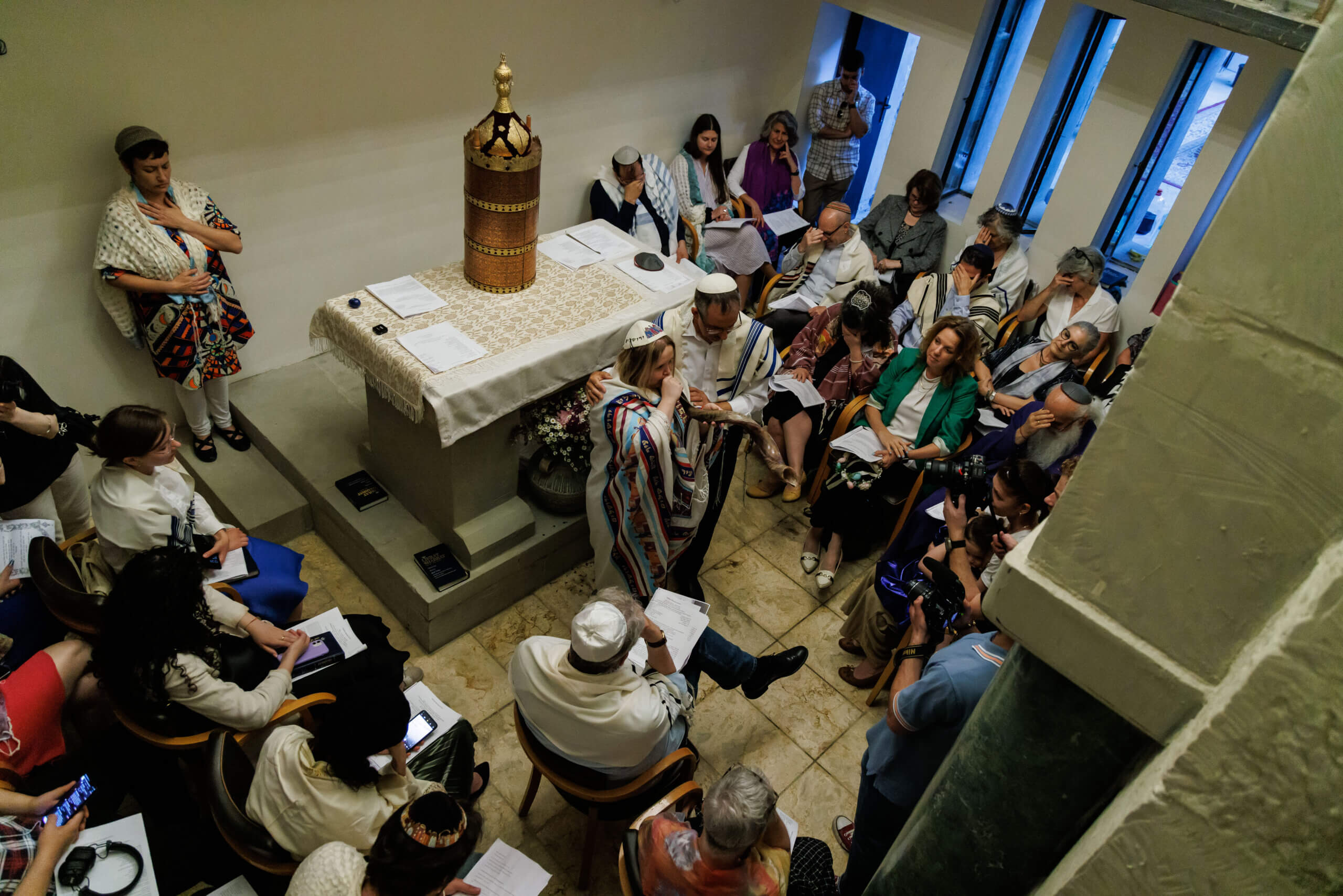
My favorite part: Instead of the congregation giving the b’nai mitzvah gifts like a kiddush cup, they each gave the community a gift of their own creativity. It felt like both a reflection of their gratitude for the unexpected opportunity to engage Jewishly — and a showcase of the place as a work in progress.
Levinets not only blew the shofar, which she had purchased in Israel, but donated it, as if to say: We will be back on the High Holidays. Misha Grishashvili, an engineer, welded a blue stained-glass window, perhaps soon to hang on the Peace Synagogue’s walls.
Laylah Jishiashvili and Lisabeta Baradzina hand-embroidered a parochet, the curtain that hangs in the ark, with a gold menorah and red pomegranates.
“Torah is the heart of a synagogue, and a heart has to be hugged so it won’t be lonely,” explained Jishiashvili, who is 36 and did not learn of her Jewish ancestry until she was an adult.
“It’s a new synagogue; I wanted it to have the soul of an old thing, like grandma made it,” she told me. “I wanted to make something with my hands. Something that I can touch and that will stay here — I won’t say forever, but for a long time.”
‘Having a community show up for them’
I decided to go to Georgia because it had never before occurred to me to do so. Because I knew virtually nothing about the place — including that it is pronounced JYOR-jee-ya, unlike the U.S. state by the same name — and could probably not have found it on a map. (It’s that little one between the Black and Caspian seas, bordering Russia, Turkey, Armenia and Azerbaijan.)
I first heard about the trip in February, when Cantor Meredith Greenberg sent an email about it to my family’s congregation, Temple Ner Tamid of Bloomfield, New Jersey. She mentioned that her parents helped resettle Jewish refuseniks from the Soviet Union in the 1980s, a cause I had also been engaged with as a teenager.
“Now, 40 years later, in an exciting turn of events, it is I who will be traveling to a foreign land,” she wrote, “and bringing with me the gifts of liberal Jewish values, ritual, and custom.”
Greenberg outlined the basic backstory of the Peace Synagogue — and the broader Peace Project’s aspirations to have Jews, Christians and Muslims praying side by side. She invited people to make prayer shawls and challah covers for the young Georgian Jews, to donate ritual objects we might have lying around — and to travel with her to Tbilisi for Shavuot, for what she described as “the first-ever Adult B’nai Mitzvah in Georgian history.”
“My sense from the start, and it wound up really being true,” Greenberg told me after we got back, “was that the isolation these young adults were feeling could only shift by having a community show up for them.”
Eight of us initially signed up, each with our own reasons. Two were helping Cantor Greenberg train the b’nai mitzvah students to chant Torah via Zoom. One described himself as a “travel whore.” Another was intrigued because her parents’ longtime health aides were from Tbilisi.
Three more synagogue members tagged along to make a Kickstarter-funded documentary about the whole adventure. Like me, they thought that with Russia’s aggression in Ukraine unsettling the region, and Israel’s new right-wing government trying to delegitimize non-Orthodox Judaism, this unconventional project in this unlikely place would make for an interesting story.
It is a story of freedom and faith, politics and identity, tradition and innovation, unfolding against a backdrop of geopolitical fear and instability.
The protagonist, in many ways, was not the b’nai mitzvah but a 60-year-old Christian bishop who looks like Dumbledore, talks like a Talmud scholar, hikes miles on muddy mountains in sandals, and never lets a guest’s wine glass go empty.
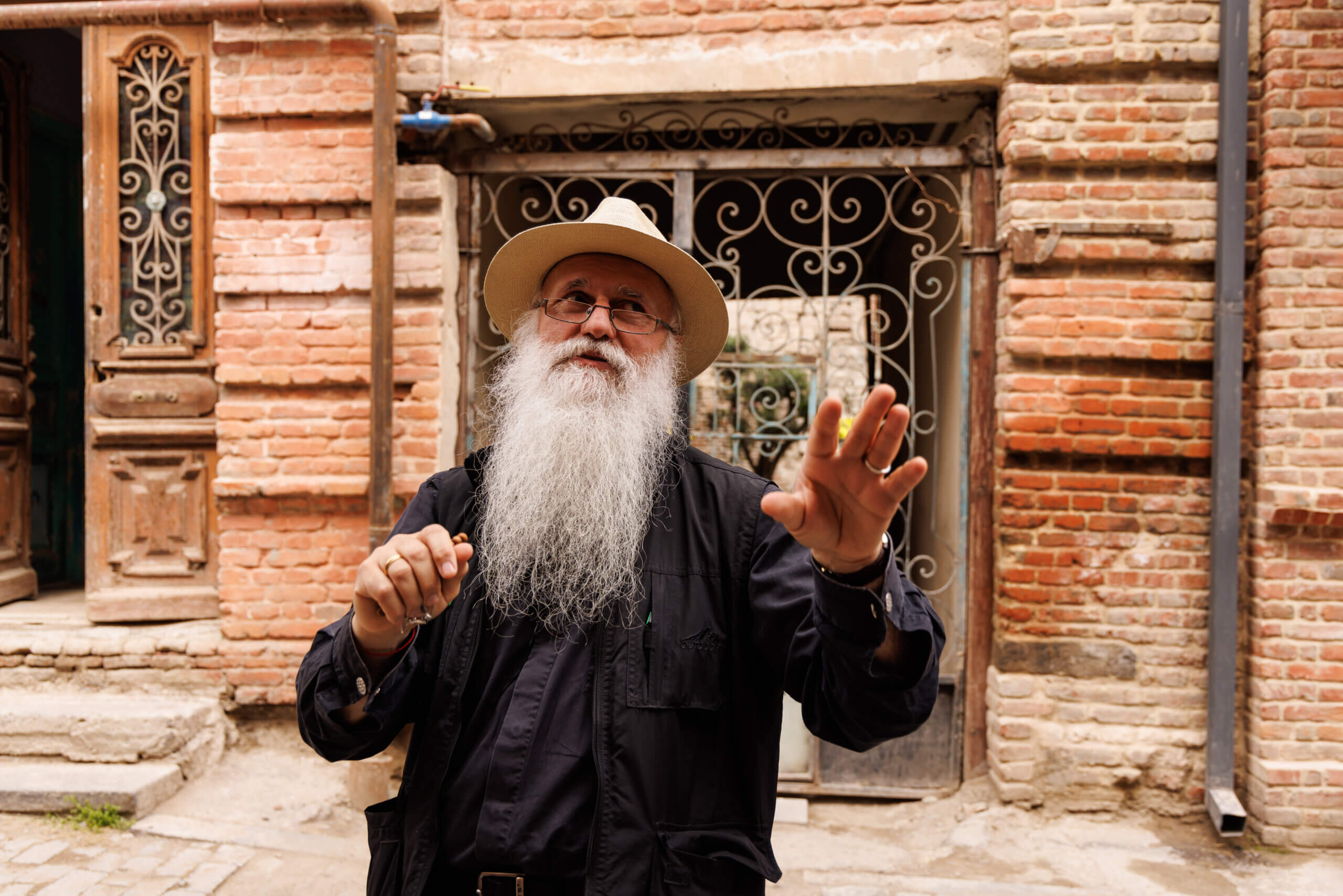
His name is Malkhaz Songulashvili. He has a Ph.D. in comparative religion from Oxford, has completed two translations of the Torah into Georgian, and is working on one of the Quran. For two decades, he was the top cleric in Georgia’s Evangelical Baptist Church, which he likes to say is “neither evangelical nor Baptist.”
It is one of the country’s smallest denominations, with about 10,000 adherents — 0.2% of the population of 3.7 million — and its most vocal on gender equality and social justice.
But the church’s board refused to stand by Songulashvili’s outspoken support of LGBTQ+ rights, leading him to resign under pressure as its archbishop in 2014. He remains the church’s Bishop of Tbilisi, a post previously held by his father, who in some ways inherited it from his own mother.
When the communists came to power in 1921, Songulashvili told us, they tried to wipe out religion in Georgia by defrocking priests, killing them or sending them to Siberia. But “people continued to worship God in domestic settings,” he said.
“They made a mistake, because it was ladies who kept the religion alive,” the bishop said of the Soviet rulers. “One of them was my grandmother. She would go to villages, she was not ordained, she would preach and keep religion alive.”
‘Every expression of holiness is valuable’
On our first day in Georgia, Songulashvili toured us around Tbilisi, which he said was settled 18 centuries before the birth of Jesus (whom he called “a Jewish rabbi.”)
Its architecture is a messy mosaic of Byzantine, neo-Classical and Brutalist, punctuated by a few steel-and-glass flourishes from shortly after the Soviet Union collapsed. Many buildings on the windy, hilly streets of the city’s Old Town were under construction; many others were collapsing from neglect.
Songulashvili knew them all. Here was the Roman Catholic Cathedral, which the Soviets used as a volleyball court — his wife played there as a child. See this theater? It used to be the largest synagogue in Georgia, until the Communists seized it. (We snuck in the back, and stood on stage as Cantor Greenberg led “V’asu li mikdash,” a song based on a line from Exodus that means, “Make for me a sanctuary.”)
We trudged up what seemed like a thousand stone steps to a Zoroastrian prayer space that the bishop said dated from the fourth century. It had a tall fireplace of eroding bricks and smelled like incense. Songulashvili explained the Zoroastrian concept of “permanent fire” — like the ner tamid, Hebrew for “forever candle,” that shines over the ark in every synagogue and gave ours its name.
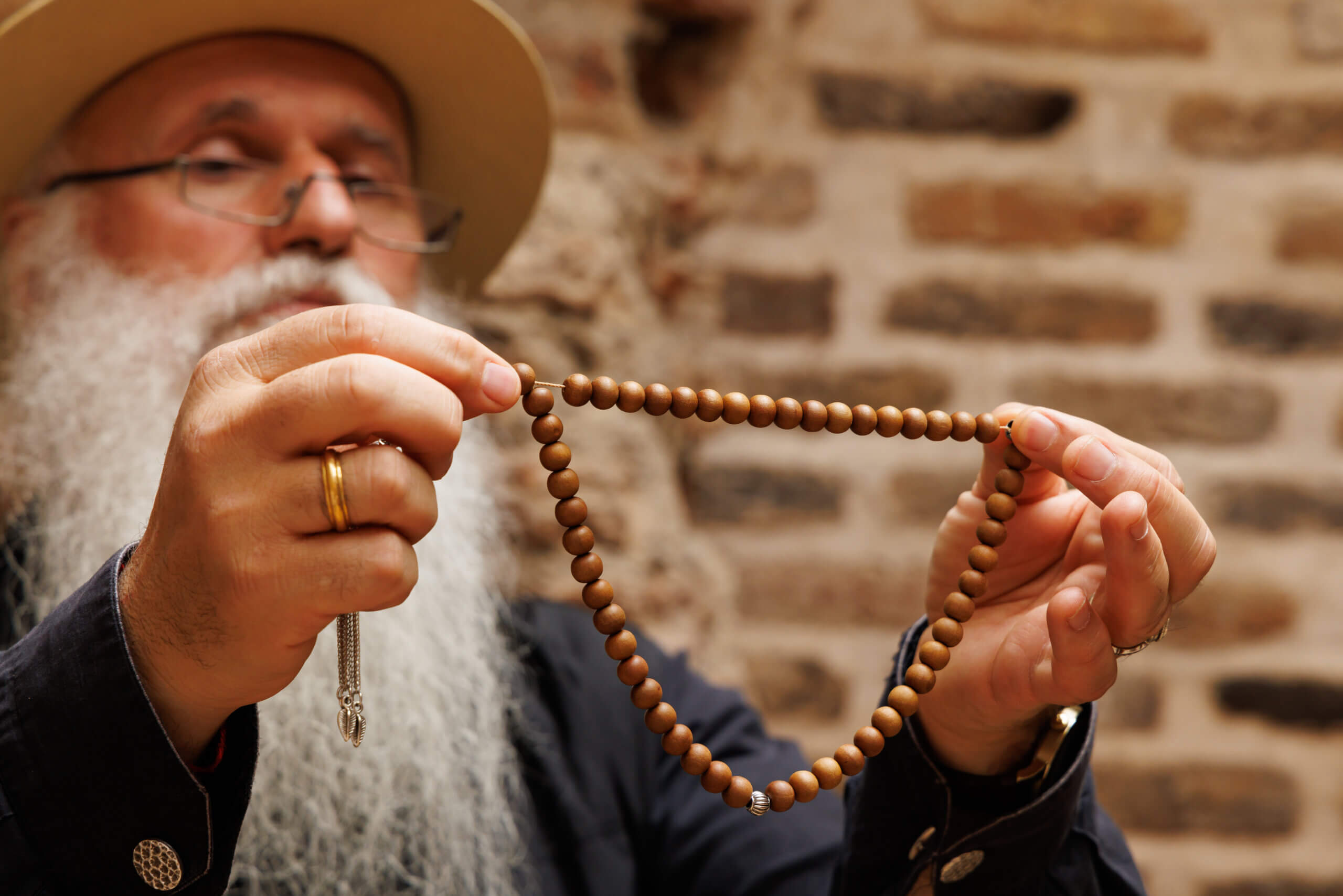
Songulashvili seemed to embody the comparative religion he studied. On Shabbat, he wore a leather yarmulke and sang the Hebrew prayers along with us like a natural. When it was time for Mourner’s Kaddish, he joined in sharing the names of his lost loved ones.
The next day for Pentecost — which marks the 50th day after Easter and the descent of the Holy Spirit upon Jesus’ followers — he was resplendent in gold-flecked vestments and crown, distributing Communion to his flock. Somehow, that service ended with a rousing rendition of “Oseh Shalom,” our prayer for peace, in both Hebrew and Georgian.
“I am very happy to chant kaddish, I am very happy to observe Shabbat — it does not make me a traitor to my faith,” the bishop told me.
“When I first started to pray with Muslims, I realized I was being liberated from fear and hatred and prejudice. Not intellectually, but emotionally,” he explained. “I’m a human being and I am praying as a human being, not as a Christian, not as a Muslim. It’s not either-or. Every expression of holiness is valuable.”
A synagogue, a church and a mosque
Bishop Malkhaz, as most people call him, was just a boy in 1971 when the Soviet government gave the Evangelical Baptists a warehouse 2 miles from their former cathedral, which had been torn down. The congregants had to clear it of debris and dig down into the basement to make it suitable for services.
Decades later, in 2017, Songulashvili decided to reinvent it as the “Peace Cathedral.” The apse is made of stones taken from destroyed villages in Georgia, and has been purposely left unfinished. “The idea is that every generation has to add their own stones,” the bishop explained.
He procured a large gold menorah and placed it at the front of church, just below a painting of Jesus with a white dove, to symbolize interfaith commitment. Then he went further, and decided to build a synagogue and mosque on either side of the cathedral.
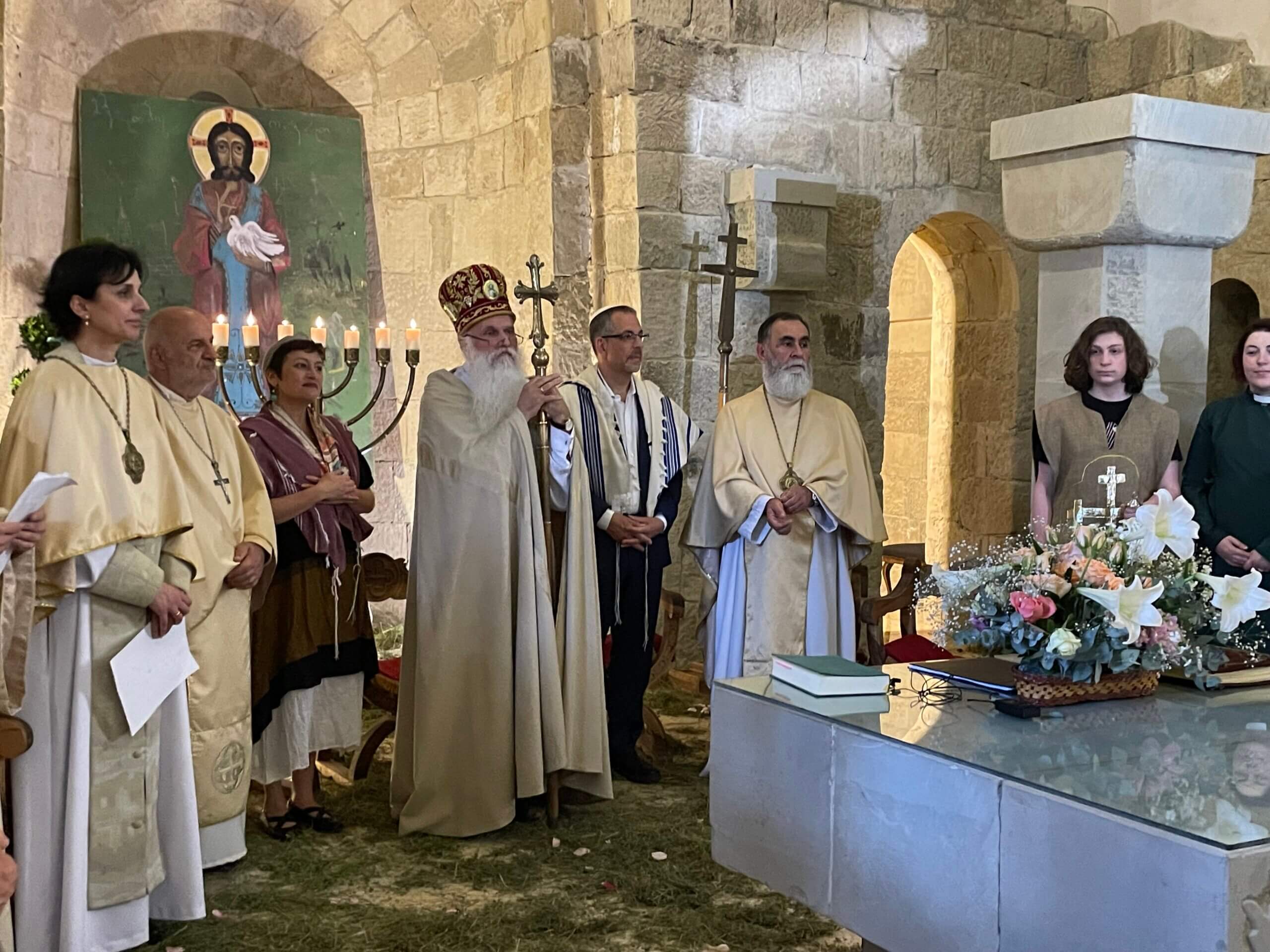
“Then we introduced a principle to make our life more difficult,” the bishop told us. “If you’re Jewish, you can’t contribute a penny to the synagogue, you can only contribute to the mosque.” And vice versa.
He said he raised about $100,000 for the synagogue, which was designed by his brother Giorgi, an architect and artisan. The two took inspiration from the Dura-Europos synagogue in Syria, which dates to the second century, and Turkey’s Sardis Synagogue, believed to be even older. The stones that form the floor are from Isfahan, Iran, where the bishop met an imam who donated 400-year-old doors from his family home to connect the church to both the synagogue and the mosque.
Giorgi’s handmade metalwork, which adorns the balcony, evokes sprouting plants and angels’ wings.
The idea for the compound was borrowed from Berlin’s House of One, an interfaith project that Rabbi Ben-Chorin’s father — the first Israeli-born Reform rabbi — helped start in 2014. The cornerstone for that compound was laid in 2021 on the site of a 13th century church destroyed in World War II, but the building is not yet complete.
A couple of years ago, Songulashvili said, some Turkish Muslims from the House of One offered him $10,000 to buy a Torah for the Peace Synagogue. He was thrilled — but stumped about how to actually procure a Torah. So he reached out to Ben-Chorin.
The rabbi, who is 55, runs an interfaith program in Haifa called the Garden of One, and last year made a documentary about Jews, Muslims and Christians playing pickleball together. (He also runs Finding North, a travel company that organized my shul’s trip to Tbilisi.)
When Songulashvili contacted Ben-Chorin about the Torah, he was immediately game to help. Except for one thing: He did not want to bring a sacred scroll to an empty synagogue. So he set out to find some Jews who might want to use it.
‘What new synagogue?’
Ben-Chorin first reached out to Israel’s ambassador to Georgia, who contacted the local Hillel director. As in other former Soviet republics, Hillel International had been working here to revive Jewish life among new generations, including those whose Jewish heritage does not meet Orthodox strictures. Its Georgia branch opened in 1997 and serves about 400 people ages 15 to 32.
The Tbilisi Hillel runs lively Shabbat dinners, field trips to ancient Jewish sites in other parts of Georgia, educational programs and holiday celebrations. But Hillel is a cultural organization, not a religious one. There was no rabbi, little prayer or text study, no b’nai mitzvah.
The group’s executive director, Keti Chikviladze, said she got a text message from the assistant to the Israeli ambassador in the spring of 2022 asking if she wanted to be a shamash for a new liberal synagogue opening soon in Tbilisi.
“What new synagogue?” she recalled asking. “I knew shamash is the main candle of Hanukkah, but I did not know what they were talking about.”
In all, Ben-Chorin recruited six shamashim for the Peace Synagogue, imagining that they would light the way, as the shamash lights the other candles on a menorah.
He brought the Torah — a 70-year-old Sephardic scroll that stands upright in its copper-colored case while being read — to the unfinished Peace Synagogue space in June 2022. Then, over several visits to Tbilisi and many more Zoom meetings, he and the shamashim wrote a covenant for the new community, defining it as a place “open for prayer and ritual to all Jews who accept all Jews’ rights to practice Judaism as they wish.”
There is, as yet, no real congregation, at least not in the conventional sense of members, regular services or other programs, a budget. Ben-Chorin said he has tried and failed to get funding from the Joint Distribution Committee, Jewish Agency, World Zionist Congress and World Union for Progressive Judaism. The Schusterman Foundation did give $5,000, which has underwritten his visits.
Levinets, the shofar blower, said she first learned of the Peace Synagogue only two months before the b’nai mitzvah, in March. Ben-Chorin was giving a talk at Hillel, and she showed up 15 minutes early. They chatted briefly, and when one of the shamashim walked in, the rabbi said: “Add her.”
‘I always practiced Judaism in the way I felt is right’
Tbilisi is 5,500 miles from New York, and there are no direct flights. I left home around 9 p.m. on a Tuesday and walked into our hotel at 5 a.m. on Thursday.
The next morning, soldiers massed in formation outside the hotel for Georgia’s Independence Day ceremony in nearby Freedom Square. A commander snaked through the lines, tucking errant tags into berets. The cafes on the cobblestone street were closed, but I noticed a few of the soldiers’ mothers hovering there, leaning over the railing to kiss a cheek.
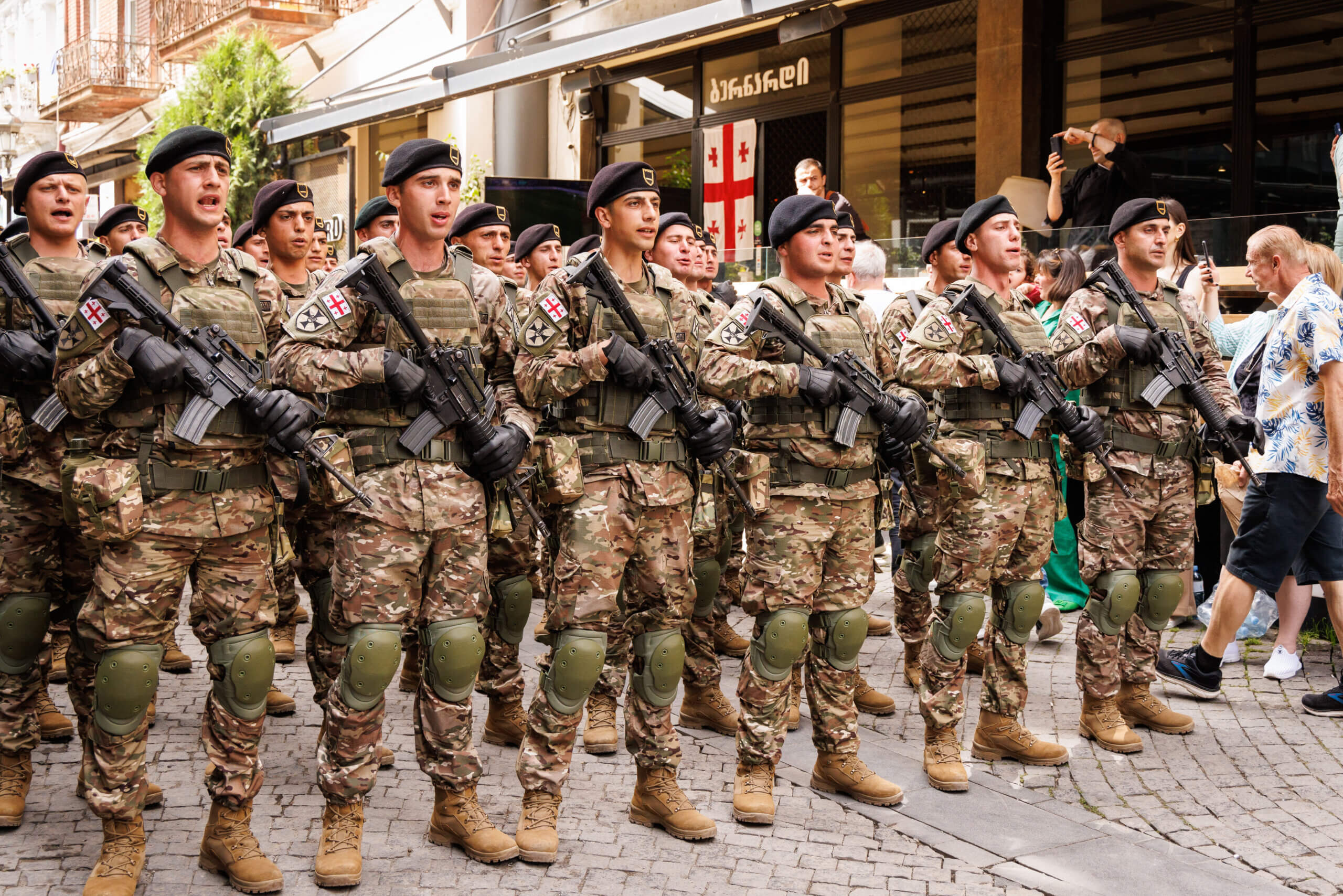
Independence Day in Georgia, especially with the war raging in Ukraine, is intense. Georgia has tried to avoid Russian President Vladimir Putin’s ire by not joining international sanctions against Moscow or providing military aid to Ukraine. But anti-Putin graffiti speckled the Old Town, and the people we met fear they will be his next target — either as a victory lap, or a consolation prize.
That night at Shabbat services, one of the b’nai mitzvah, Tornike Namicheishvili, 32, wrapped himself in Georgia’s white and red flag as if it were a tallit.
Historians say the first Jews to arrive in Georgia were fleeing the conquest of Jerusalem by Nebuchadnezzar in the sixth century B.C.E. Today, estimates of the Jewish population range from 1,500 to 6,000; most left after the Soviet Union fell in 1991.
Levinets’ husband, Yossi, and Chikviladze’s, Misha Grishashvil, were in elementary school then. They remember having to chop wood to heat their homes — and having to lug logs to school twice a week for their classrooms.
In those early post-Soviet years, they said, the Jewish Agency and Joint Distribution Committee offered vouchers for food and electricity, as well as free camps for Jews. Many families that had hidden or forgotten their Jewishness over generations signed up, including Chikviladze’s.
Grishashvili told me the story because he is more comfortable talking in English. Chikviladze’s grandmother’s father was a rabbi who studied at a yeshiva in Vilna, he said. This great-grandfather married the head rabbi’s daughter, whose name was Rachel. The couple “died mysteriously,” Grishashvili said, and their children — Chikviladze’s grandmother and great-uncle — ended up in an orphanage in the Russian city of Nalchik, which the Germans occupied in 1941.
After the war, the grandmother became an engineer and was sent to work in a factory near Tbilisi. “She was raised in a Communist orphanage, she didn’t give a damn about Judaism,” Grishashvili said.
Two generations later, her granddaughter Keti, who went to those free Jewish camps, has been a counselor on Birthright trips to Israel; wears a Star of David pendant; runs the country’s Hillel; is one of the Peace Synagogue’s shamashim; and was one of the women who made history reading Torah.
“Here in Georgia, people — especially men — think women should have certain roles, like baking cookies and making dinner,” she told me. “I was in U.S. six years ago, and to see women wearing kippah, it was very meaningful.”
Now she is seeing it right here in Tbilisi, in the congregation she is trying to help create. Several of the women who read Torah, like Levinets, wore them during the b’nai mitzvah.
Levinets, whose father used to work for Chabad in Tbilisi, said she learned the Shabbat prayers at age 9 via Russian translation. She recited them, lit Shabbat candles and studied Torah on her own because she could not find a comfortable place among the Orthodox. A few months before meeting Rabbi Ben-Chorin, she had stumbled across a woman talking about her practice of Conservative Judaism, and felt both inspired and validated.
“I always practiced Judaism in the way I felt is right,” Levinets told me. “If I’m using mobile phone on Shabbat, I’m not using it for work, I’m using it to call my sister, who for seven years has lived in New York.”
Bumpy yet bashert
We were chatting in what Bishop Songulashvili calls Abraham’s Hall — an unfinished space with a concrete floor and a corrugated roof — where visitors to the Peace Cathedral, Peace Synagogue and Peace Mosque are meant to gather in fellowship.
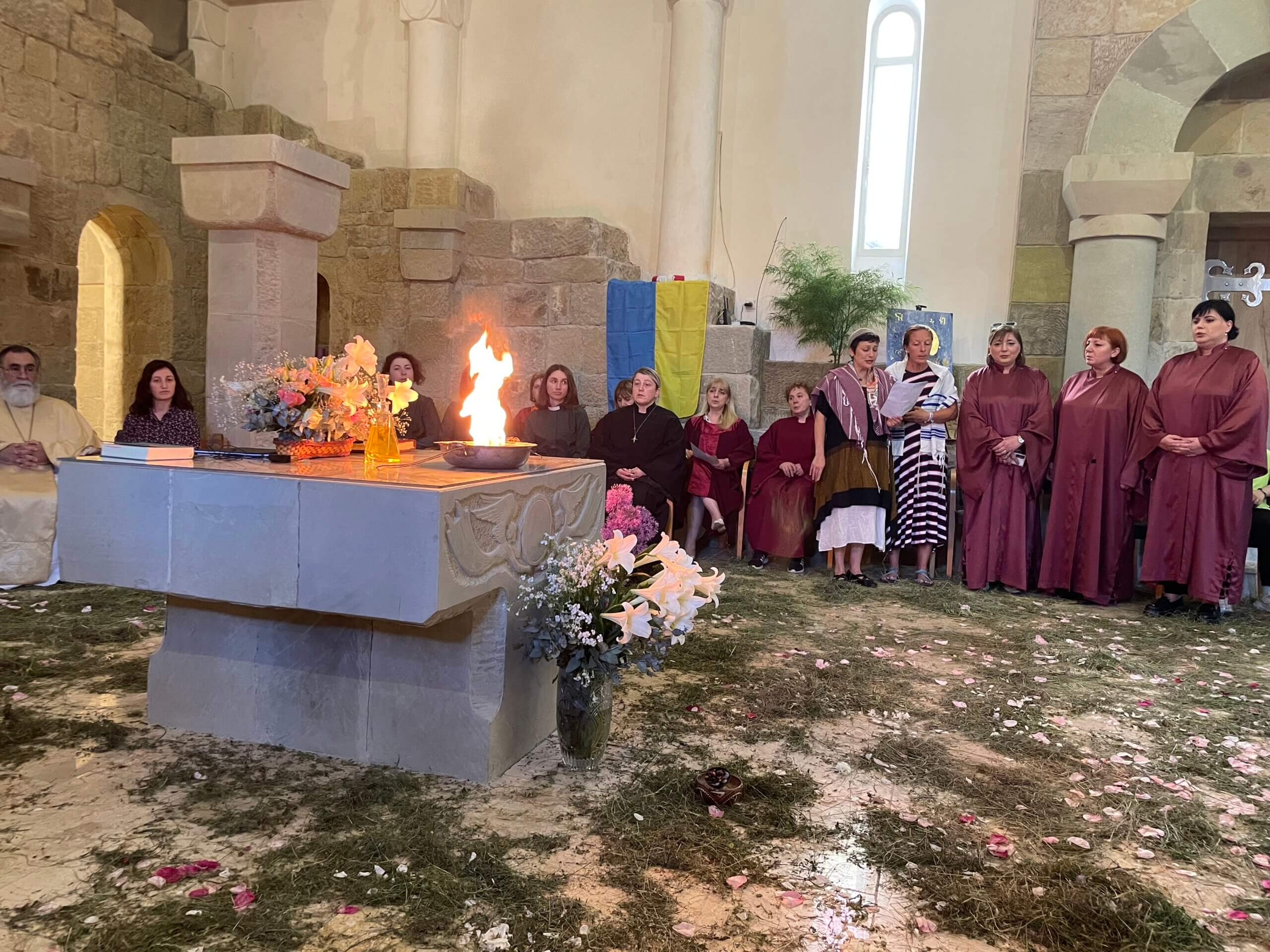
Which is exactly what we did after Shabbat services on Friday night and Saturday morning, and Sunday’s Pentecost, a moving, multi-sensory experience different from any church service I have been to in the U.S.. For each, church members prepared a lavish spread: mushroom soup one day and sour yogurt soup the next; Georgia’s signature cheese bread, khachapuri, and ground-walnut-and-vegetable pastes; fresh strawberries, mini sour green plums and hazelnuts from local trees; and plenty of natural wine, which the bishop himself made sure everyone sampled.
Tornike Namicheishvili, the man who wrapped himself in the Georgian flag for Shabbat, told me his story during Friday’s feast. Unlike the other b’nai mitzvah, he said, he does not consider himself Jewish — he is an Orthodox Christian, like more than 80% of Georgia’s population. But he said he has been fascinated by what he called “Hebrew culture” since he was a toddler.
That’s when a friend of his father’s visited from Israel and brought him books about Snow White and Pinocchio, which he treasured. “My parents told me that he was Jewish – this was the first time I heard the word,” Namicheishvili recalled. “As I grew up, I learned that Jesus was Jewish. I heard about Prince of Egypt.”
At university, Namicheishvili became friends with Chikviladze, and started hanging out at Hillel. He is a tour guide who speaks both Hebrew and Yiddish, and on a trip to Poland, he visited Auschwitz and Schindler’s factory.
But despite joining the b’nai mitzvah, he does not plan to convert to Judaism. He likened himself to a zoologist going “into the wild to see the animals,” then quickly realized that analogy sounded bad. “When you experience something on your skin,” he said by way of explanation, “it means more than reading it in a book.”
Sure, I thought, but isn’t the bar mitzvah experience supposed to be … for Jews? It’s one thing to be flexible about ancestry or conversion requirements, and quite another to open an ancient Jewish rite of passage to a person who considers himself Christian.
When I asked Ben-Chorin about Namicheishvili, he at first did not seem to share my concern, saying that each person was on a different point in their “Jewish journey.” But the next day, Ben-Chorin told me I should talk to Namicheishvili again. This time, the tour guide mentioned that one of his great-grandparents might have been Jewish.
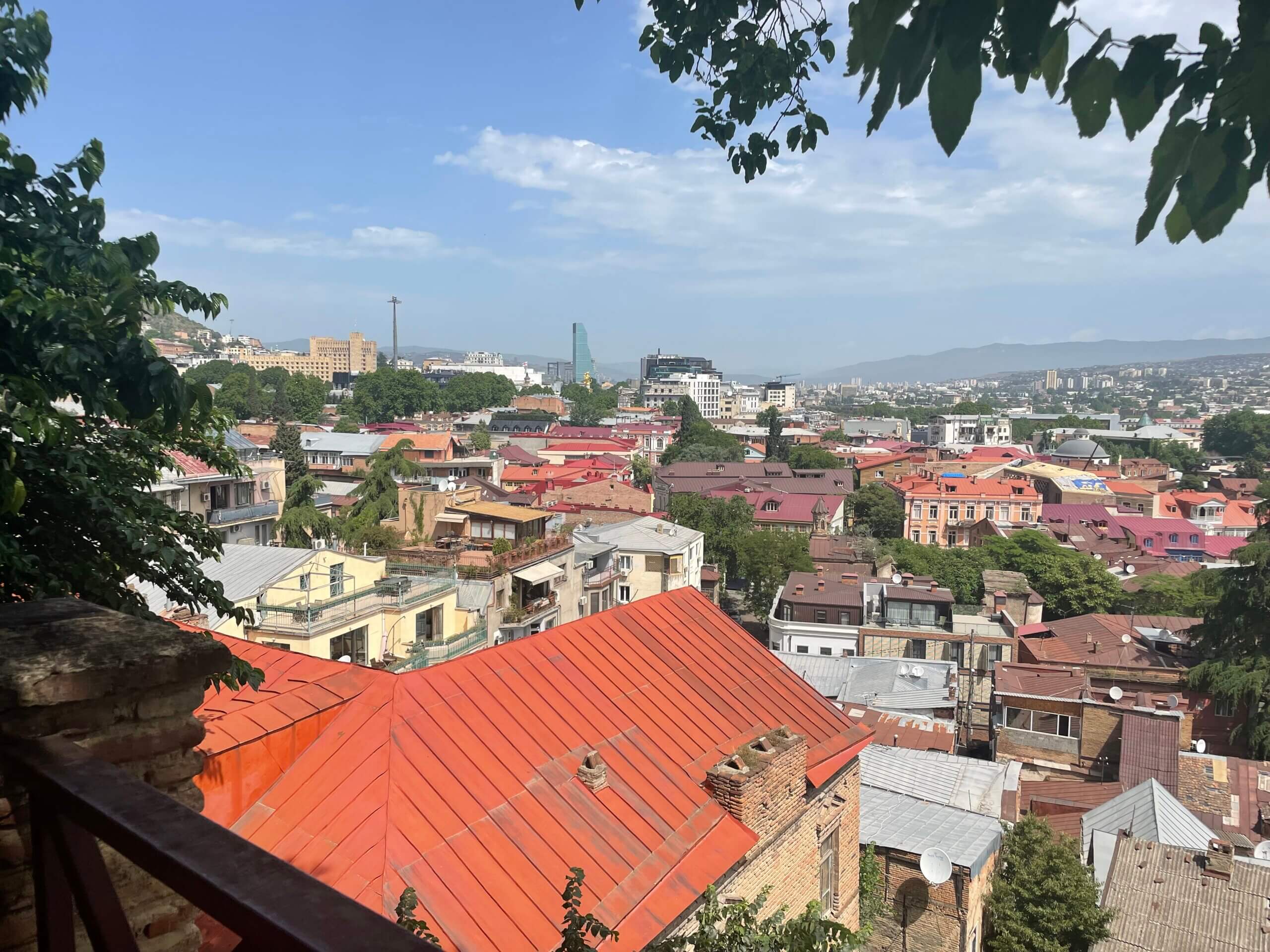
I am not interested in policing people’s Jewish heritage. But I knew the synagogue’s critics would seize upon this tidbit to delegitimize it, and I also felt it compromised the ceremony for the b’nai mitzvah who may not have grown up with Judaism but were now fully committing to it.
One of those is Nina Mgeladze, the singer who set the liturgy to Georgian music. Over a Shavuot feast at the home of the Israeli ambassador, Hadas Meitzad, on Thursday night, she told me that her father’s father was Jewish, but “never spoke about it” because of antisemitism after World War II.
Mgeladze’s own father converted to Islam, while she and her mother converted to Orthodox Christianity when Nina was 17. Around the same time, she said, she started asking questions about the Jewish great-grandmother she was named after, a doctor who spoke multiple languages. Mgeladze still went to church — but also to Jewish camps and Hillel programs.
“I always felt some level of responsibility to carry on her legacy,” she said of her great-grandmother. “As I learned more about Jewish culture, it was like some emptiness is filling inside me.”
Laylah Jishiashvili, one of the women who hand-stitched the ark curtain, also had a path to the bimah that seemed at once bumpy and bashert, meant to be.
“Everyone always asks little kids, ‘What do you want to be when you grow up?’” she told me. “Some say ballerina, some say astronaut. When my parents asked me, I would say, ‘I want to be Jewish.’”
About a dozen years ago, Jishiashvili got a call from a half-uncle in Russia who was researching the family tree. He asked, “‘Will you feel bad if you know your great-grandmother is a Jew?” she recalled. “I said, ‘Wow, thanks, I’ve been searching for it for many years.’”
She, too, made her way to Hillel. But when Grishashvili told her about plans for the Peace Synagogue and invited her to become a bat mitzvah, Jishiashvili was dubious.
“I’m not a traditional person, I don’t have my documents, I’m not officially Jewish,” she explained. “I know that Georgia is a very Orthodox country. I didn’t trust that someone will let this place be.”
‘A severe and brutal response’
The backlash began two days before the b’nai mitzvah. At the ambassador’s Shavuot dinner, the young Georgians hovered at a small table, showing each other their smartphones. A dozen Georgian rabbis, some of them now living in Israel, had signed a Facebook post denouncing the Peace Synagogue.
“The opening of a synagogue in a place of worship of other faiths is not allowed,” it said. “All Jews who participate in this event grossly violate the Torah.”
(The Peace Synagogue is not, in fact, in “a place of worship of other faiths,” but rather adjacent; the bishop, knowing that some Jews are uncomfortable entering a church, made sure to build the synagogue and the mosque with two entrances each — one from the cathedral and one from the outside.)
After the Facebook post, Chikviladze, the Hillel director, got a call from a member of the Hillel board of directors, saying she should skip the synagogue opening — he suggested saying her children were sick. She said she was told her Hillel job could be in jeopardy.
Over the weekend, Grishashvili — Chikviladze’s husband and the new synagogue’s president — was sent what he called a “KGB-style” video of himself getting out of his car outside the Peace Cathedral.
When I called Osik Akselrud, Hillel’s regional director overseeing Ukraine, Belarus, Azerbaijan, Moldova and Georgia, he said he had told Chikviladze only that she must be clear that she is participating in the Peace Project as an individual, not as a Hillel leader.
“If she will visit on behalf of Hillel, she will have a problem,” he said. “Hillel cannot be part of the Peace Synagogue, because we will lose the connection to the traditional community. Georgia, it’s a special area, the Jewish community is very conservative.”
I had experienced that conservatism myself when I went to Tbilisi’s two established synagogues to say kaddish for my father.
The smaller one, Beit Rachel, is hard to find, tucked in an alley behind a tourist strip of cafes, a hotel and an Enterprise car rental. When I went to open the door, a man barked at me in Georgian; I had not realized that women had to use a separate entrance to the building itself.
That entrance led to a balcony edged with a tall lattice barrier, through which I could barely glimpse the men davening below, nor hear well enough to even know when it was time for kaddish.
A few minutes walk up the street is the Great Synagogue, where a leader named Khaim Nisanovi told our group that there have been services every day since the building was completed in 1911. It has two lovely sanctuaries, one atop the other, with inlaid tilework and soaring stained glass.
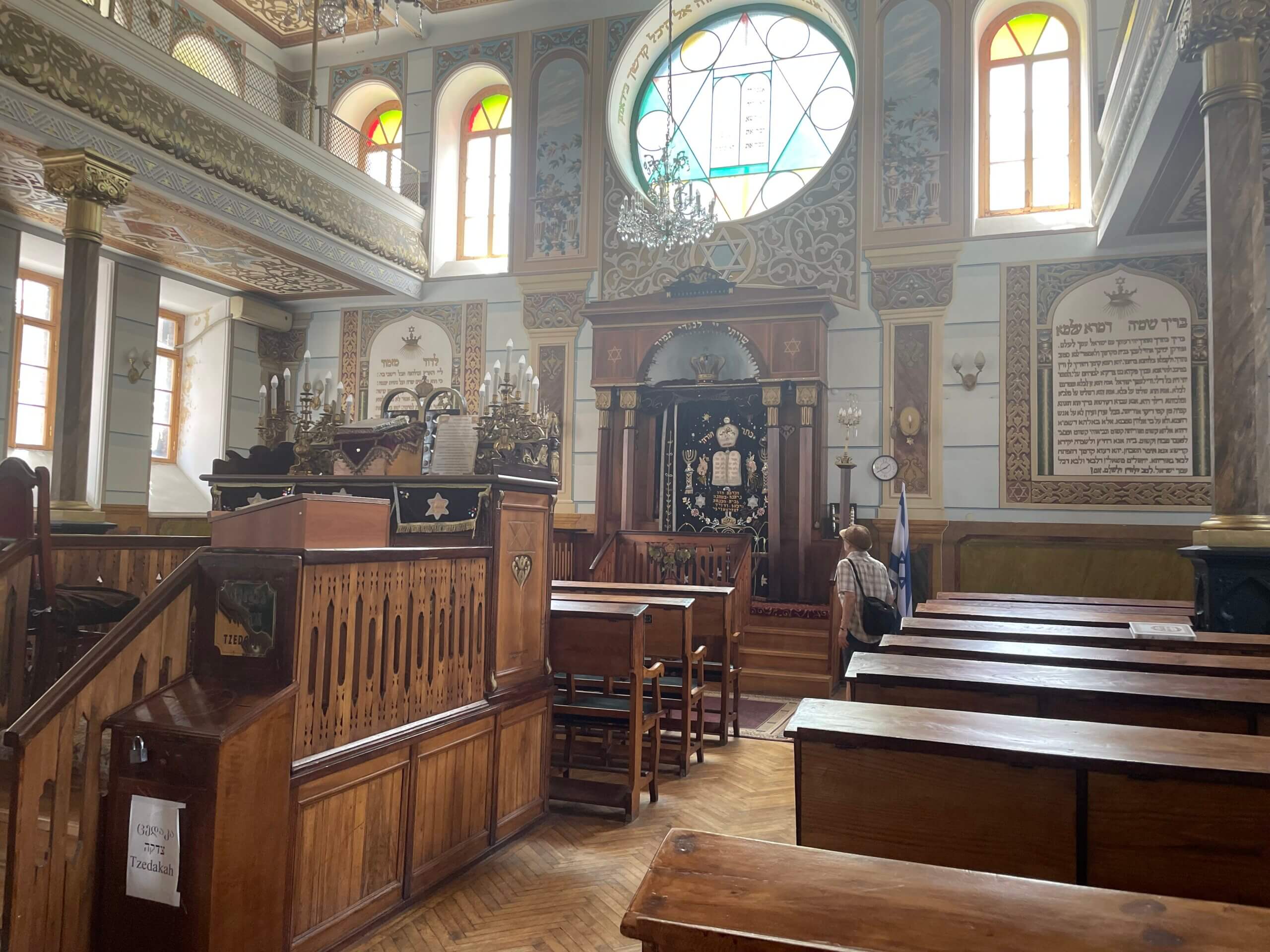
Nisanovi, 72, said he speaks 11 languages and that his mother used to live at Ocean Avenue and Avenue M in Brooklyn. But when I asked a question, he said in broken English: “I don’t like people talk too much.” And when I returned for minyan a few mornings later, sitting alone in the small women’s section in a back corner, he did not recognize me.
A few days after I left Tbilisi, Georgia’s chief rabbi presided over a meeting at the Great Synagogue to plot a response to the Peace Synagogue. A Facebook post referred to the new shul as “a reformist shrine” and to “so-called bar mitzvah and bat mitzvah rituals for non-Jews.” It said the chief rabbi had asked Israel’s foreign ministry to look into the matter, and that the sexton of the Great Synagogue had formed a group to plan “countermeasures against this offensive event and to eliminate it.”
“The Georgian Jewish community and its leadership will not allow anyone to touch the honor of the Jewish faith, which our ancestors preserved for 2,600 years,” it continued. “Their actions will be met with a severe and brutal response.”
I was outraged by the insulting characterizations of liberal Judaism — and by Facebook commenters who suggested that Rabbi Ben-Chorin be “crucified like Jesus Christ,” and his followers “burned on the fire.” Johanna Ginsburg, who lives in New Jersey and is Ben-Chorin’s partner in the travel company, urged members of our group to report the post to Facebook as a form of hate speech.
“When the Orthodox are mad at us, I feel energized,” Cantor Greenberg had told us back in Tbilisi after the first whispered threats from Georgia’s rabbis surfaced.
“We must be really doing something radical for them to be this pissed off,” she said, adding: “They don’t know how much we have in common. That we’re coming from a place that also has a deep love for this tradition.”
In fact they didn’t know anything about the enterprise, because no one had tried to talk to them about it. Now, Grishashvili told me, the shamashim are holding off submitting the synagogue’s official registration to the government for fear those listed on the papers will be harassed.
“It is something that is really hard to deal with, because when you want to make some reaction right out of your emotions, you’re always thinking about the people that it may backfire on,” he said. “At this point, I think it’s not about Hillel and it’s not about the Peace Synagogue, it’s about the principle of what humanity and democratic society stands for. It stands for choice. In Torah, we know this is the only thing that separates humans from all other creations of God:.”
A row of doors, a river
The Peace Mosque sits on the other side of the church from the Peace Synagogue. They’re about the same size. But instead of a stone floor, the Muslim prayer space has a soft olive-green carpet with decorative diagonal stripes indicating where worshippers kneel.
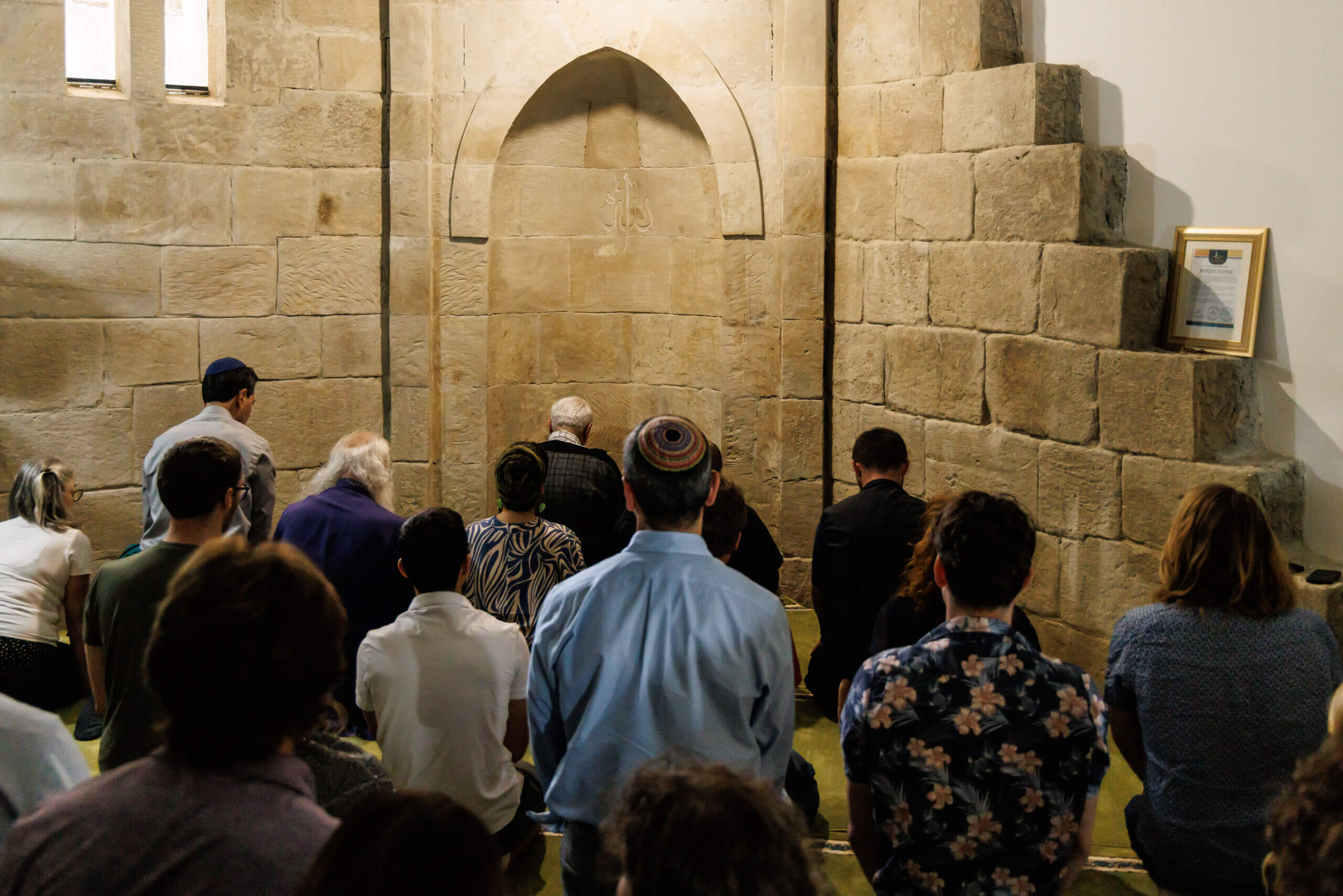
Before we entered the mosque for Friday prayers — called Juma’a — Rabbi Ben-Chorin prepped us by saying that everyone has their own “comfort zone, stretch zone and flight zone.” If something makes you uncomfortable about the situation, he suggested, don’t flee: “Check out the stretch zone.”
I was already a bit uncomfortable about the fact that there were no actual Muslim congregants in sight. There were two imams, one who lived in Tbilisi, and one who we were told had traveled 40 hours by bus from Iran for this interfaith extravaganza. But the others entering the mosque for its “historic” consecration were us Jews from New Jersey, members of the bishop’s Peace Cathedral flock, and a group of students from a Baptist university in the U.S. state of Georgia who were on a service-learning trip. It seemed like something of a show.
I sat with my back against a side wall, to observe. Some of my synagogue friends and some of the college students lined up on the diagonals. Bishop Malkhaz took a spot in the front row, and then extended his hand to Cantor Greenberg to join him.
The imam began to chant in Arabic. I have covered Muslims for many years — Palestinians in the West Bank and Gaza, Syrian refugees in Jordan, Americans in the aftermath of 9/11 — but since their prayer spaces are generally segregated by gender, I had never been so close to an imam at work.
When he bowed the first of four times, Greenberg and several others from our group bowed as well, touching their foreheads to the olive carpet. “Allahu akbar,” he chanted, Arabic for God is great.
When it came time for the second prostration, I noticed that at least one member of our group, a retired venture capitalist named Rob Rosenberg, stayed upright. But both my good friend Amy Friedman and Cantor Greenberg bowed again — and twice more to complete the prayer cycle.
“I tried it, and just didn’t feel right,” Rosenberg said afterward. “I hear the ‘Allahu akbar’ and it doesn’t feel like something that is mine, it feels like something that is against me.”
Friedman, who works in children’s television, said the physicality of touching her forehead to the floor sparked a spiritual connection she rarely feels in shul. Greenberg said she, too, appreciated the opportunity to engage her whole body in prayer — and that she was comfortable doing so because of the trust she had built with the imam and the bishop.
“We all had prayed together the night before in the Jewish tradition, and it felt so right to be exchanging religious technologies and exploring them with one another,” she told me later. “God is God is God. Mostly I struggle with God through the Jewish lens. But who’s to say I can’t also deepen by hearing the struggles people are having in their traditions?”
Two days later, Pentecost gave us another opportunity to engage with the rituals of another faith. The Peace Cathedral had been transformed. Fragrant pine boughs filled the floor. A mesmerizing fire blazed atop the altar. The choir filled the cavernous space with hymns.
I felt more engaged and less alienated than I had in visits to U.S. churches, and in the Peace Mosque. I think that’s because the singing was in Georgian, so I had no idea what was being said. In contrast to “Allahu akbar,” a phrase that long ago entered our lexicon because terrorists twisted it into a battle cry, or to English paeans to Jesus.
I wondered, in a way I never had before, how non-Jewish guests at synagogues feel when they hear us sing in Hebrew. Warmed by the musicality and communal vibe? Or worried that if they hum along they might be crossing a theological line?
Several of us parsed the experience on our 25-hour trek home. Friedman offered a metaphor for the Abrahamic faiths’ mutual belief in one God. Imagine a row of doors that all lead to the same place, she said, perhaps a river. Usually, Jews, Muslims and Christians walk through our own doors, into rooms with walls, inside of which we have our own specific prayer traditions.
What if we walked through a different door, she suggested, or if there were no rooms, no walls — since we’re all headed to the river anyhow?
For me, though, Judaism is less about God — or, in this metaphor, getting to the river — than about community. Synagogue services, too, are often less about spirituality than about embracing tradition and culture.
I like being in a room that feels familiar and comfortable. And I like feeling connected, both to other members of my tribe — singing the same songs and reading the same Torah portion on the same day around the world — and to my parents and their parents and back through generations.
Which is why it was so special to stand alongside the historic b’nai mitzvah in the Peace Synagogue, to say “amen” as women were called to the Torah in Georgia for the first time.
‘She made it all feel as if this is your birthright’
As we piled into the tiny Peace Synagogue — “it fits 45 comfortably, and 60 uncomfortably,” Bishop Songulashvili said — for the historic Shabbat service, the b’nai mitzvah were a typical mix of terrified and triumphant. And the makeshift congregation surrounding them was delightfully eclectic.
There was a British expat who once expressed her alienation from Judaism by introducing herself to strangers as a Sufi Muslim — and had since started writing Torah commentaries for the Peace Synagogue’s website. A French Jew living in Tbilisi brought his fiancee, who is from Louisiana and studying for conversion. (His grandmother had shown her pictures of his bar mitzvah, but she’d never actually witnessed one.)
The leading Reform rabbi and rebbetzin from Minsk, who were in Georgia on holiday, had turned up. So did a gay Israeli teenager traveling through town, and the three sisters who anchor the choir of the Peace Cathedral.
Plus our group from New Jersey, with a bagful of homemade tie-dyed prayer shawls for our new friends.
Ambassador Meitzad sat in the front row with her 3-year-old daughter, who wore a shiny blue cape and flowers in her hair. To their left was Levinets and her father, Tzvi; he’s the one who taught her to blow shofar, having learned himself after playing cornet in the Soviet army.
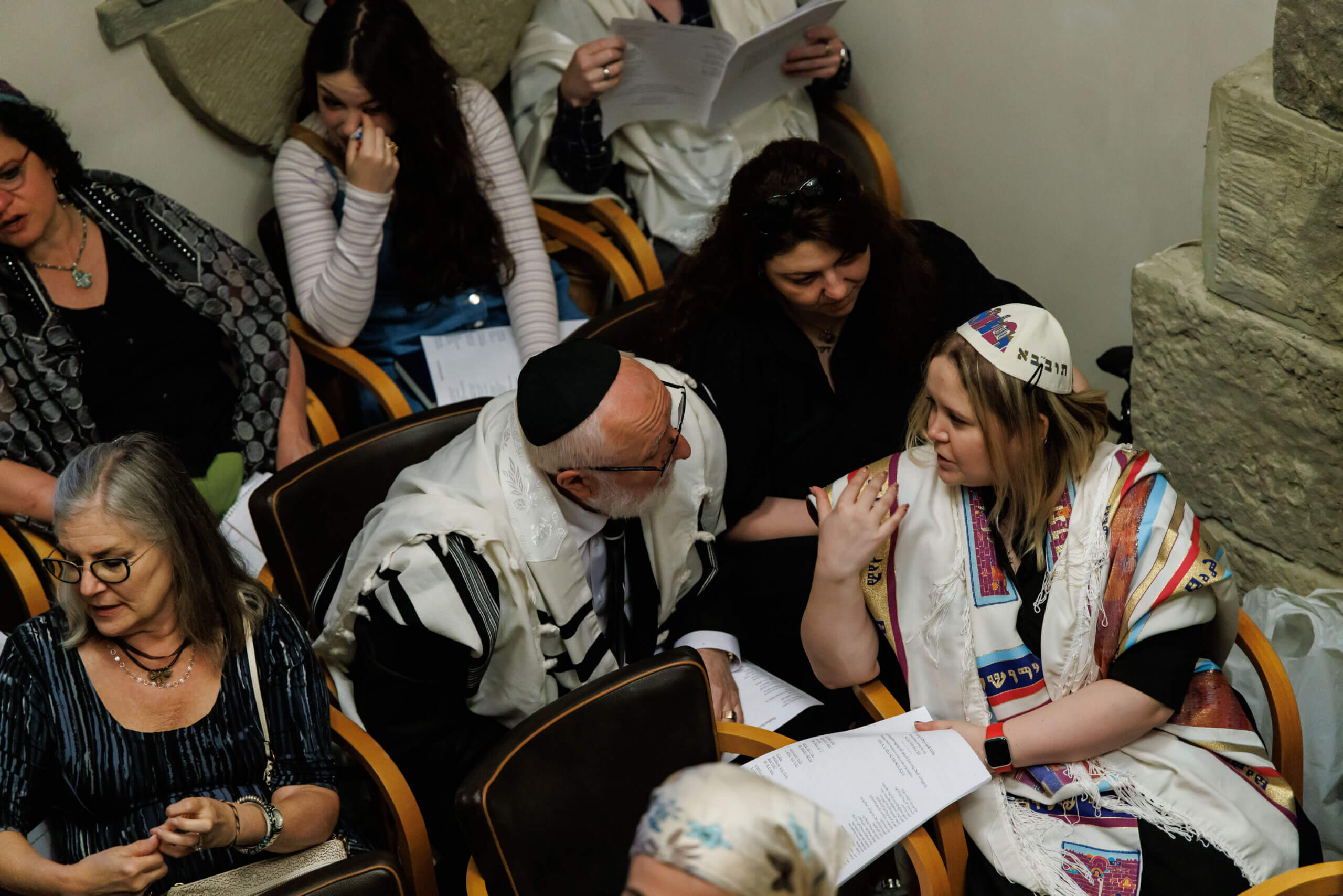
We used prayer booklets Rabbi Ben-Chorin and Cantor Greenberg created for the occasion, with transliterations in both English and Georgian — likely another first. The rabbi’s voice caught with emotion as he spoke to the b’nai mitzvah, huddled under a large tallit, and recited the blessing Jewish parents give their children on Friday nights.
“I feel this is a moment of mishpacha, of family, of Judaism,” he said. “Of the strength of people who make their choice to be active on their Jewish journeys.”
They ascended the bimah one by one or in pairs; Chikviladze and Grishashvili, the married couple, had their aliyah together. As with the 13-year-olds in our congregation back home, some stumbled and some soared as they read from the stand-up scroll.
One member of our New Jersey contingent, a lawyer named Amy Winkelman, said she was particularly moved by the dignity and seriousness that Jishiashvili, the ark-curtain maker, brought to her chanting.
“I thought about the women in my family, and especially my mother, who fought so hard for the right to do this,” Winkelman said later. Her mother had successfully lobbied their Conservative Ohio synagogue — “it seemed to me, single-handedly,” she said — to allow girls to have the same Jewish coming-of-age ceremonies as boys. Hers was in 1975.
“I remember going shopping with her for my tallit, at the dusty old Judaica store on Taylor Road in Cleveland Heights,” Winkelman said. “She made it all feel as if this is your birthright.”
I did not read Torah at my own bat mitzvah 40 years ago. I grew up in an Orthodox synagogue where that was reserved for boys at the time, so instead I chanted a haftarah, from the Book of Prophets, and gave a little speech about its themes.
Maybe that’s why I’ve always been intrigued and impressed by the go-to Torah readers at seemingly every synagogue who can seamlessly read virtually any portion. At our shul, two of those mainstays are Kenny Cohen and Morty Bernstein, who joined the Tbilisi trip after helping train the b’nai mitzvah students over Zoom.
Cohen, a lawyer and fundraiser, is the son of a Conservative cantor. After his bar mitzvah, he earned $10 a week — eventually $15 — chanting each week’s Torah portion at their Long Island synagogue.
Bernstein, a retired software engineer, was the class clown in Hebrew school, always getting sent to the principal’s office. When the school hired a new principal, Bernstein recalled, “He said, ‘You’re not going to sit there and do nothing, I’m going to teach you how to read Torah.’”
Now it was Bernstein’s turn to teach. He met with Chikviladze and Grishashvili over Zoom. Sometimes their young children, Benjamin and Esther, popped onto the screen to say hello.
Grishashvili already knew how to read Hebrew, because he’d lived in Israel for a few years as a child, and spent two more studying at the yeshiva behind Tbilisi’s Great Synagogue. When Chikviladze struggled, Bernstein suggested she ignore the trope and just try to learn the words.
On the big day, they both did just fine. As he stepped down from the bimah, Grishashvili gave Bernstein a vigorous high-five.
This was the image I’ll never forget. Grishashvili, the young president of the nascent Peace Synagogue, the husband of the Hillel director bearing the brunt of the Orthodox backlash, beaming just like my own son had at his pandemic-scarred Zoom-mitzvah in 2020.
But what will become of this fledgling project in this fraught place?
In the six weeks since the b’nai mitzvah, the Georgian Jews we met have not been back to the Peace Synagogue. The sexton of Tbilisi’s Great Synagogue who promised “countermeasures,” meanwhile, has continued his assault. On July 2, he emailed Hillel leaders around the region saying he was refusing to work with the Tbilisi chapter “unless their management changes” and would “do everything in my power to expose their anti-Jewish and anti-religious activities.”
It’s certainly hard to square that with a video Ben-Chorin sent to our WhatsApp group of the b’nai mitzvah and others at a Hillel-Tbilisi Shabbat dinner in June. They were seated at a long table with lit Shabbat candles and wine from kiddush. A string of small Israeli flags hung overhead. The men wore white yarmulkes.
Mgeladze, the singer, and Jishiashvili, the ark-curtain maker, led the group in “Or zarua latzadik,” a psalm from the Friday night liturgy whose lyrics mean, “Light is sown for the righteous, and joy for the upright of heart.” Namicheishvili, the non-Jewish tour guide, was holding a guitar.
Grishashvili had his daughter, Esther, who is not yet 2, on his lap; his 5-year-old son, Benjamin, was in the next seat. Maybe they will become b’nai mitzvah someday. Maybe at the Peace Synagogue.
